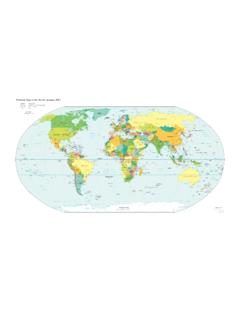Transcription of HM1.1. HOUSING STOCK AND CONSTRUCTION - OECD
1 OECD Affordable HOUSING Database OECD Directorate of Employment, Labour and Social Affairs - Social Policy Division LAST UPDATED 18/10/2022 HOUSING STOCK AND CONSTRUCTION Definitions and methodology1 This indicator presents available data on the HOUSING STOCK and HOUSING CONSTRUCTION across OECD and EU countries. Data were collected through the OECD Questionnaire on Social and Affordable HOUSING , as well as from information available from national statistical institutes. For the scope of this indicator, by dwelling STOCK or HOUSING STOCK , we refer to the total number of dwellings in a country.
2 A dwelling is a room or suite of rooms and its accessories in a permanent building or structurally separated part thereof, which by the way it has been built, rebuilt, converted, etc., is intended for private habitation. It should have a separate access to a street (direct or via a garden or grounds) or to a common space within the building (staircase, passage, gallery, etc.) (OECD, 2001). A dwelling is considered to be occupied if it provides the usual place of residence to a household, which can include one or more persons. Among dwellings that are not occupied, we define as vacant dwellings those that are not: secondary or holiday homes or dwellings meant for seasonal use.
3 Furthermore, we distinguish between dwellings located in urban and rural areas. Definitions of what constitutes an urban or rural area vary across countries, and are usually based on the size of locality and/or population density in a given area. Finally, data on HOUSING CONSTRUCTION refer to the number of dwellings that were completed during a given year and are ready to be occupied. Key findings Figure considers the availability of HOUSING in OECD countries in relation to the population. Additional data, including the total number of dwellings in each country and the number of dwellings per thousand inhabitants, are provided for the years 2011, 2018 and 2020 in Table in the online worksheet.
4 The number of dwellings per thousand inhabitants is around 468, on average, among OECD countries, below the EU average of 495 in 2020. There are considerable differences across countries. The number of dwellings in relation to the population is highest in Greece, France, Italy, Portugal, Bulgaria, Finland, Spain and Latvia (with over 550 dwellings per thousand inhabitants). In contrast, the number of dwellings reported is the lowest in South Africa (283), Colombia (294), Korea (310) and Costa Rica (310). The number of dwellings per thousand inhabitants increased between 2011 and 2020 in all but six countries: Croatia, Ireland, the Czech Republic, Iceland, New Zealand and Luxembourg.
5 Chile, Lithuania and T rkiye reported the biggest increase in the number of dwellings per thousand inhabitants over this period. This document, as well as any data and any map included herein, are without prejudice to the status of or sovereignty over any territory, to the delimitation of international frontiers and boundaries and to the name of any territory, city or area. xxx XXX XXX 2 . Figure Dwellings per thousand inhabitants Total number of dwellings per thousand inhabitants, 2020 or latest year available ,2 Notes: 1. Data are for 2020, except for Australia (2018), Brazil (2019), Bulgaria (2017), Canada (2016), Chile (2017), Colombia (2018), Croatia (2013), Cyprus (2018), Czech Republic (2011), Estonia (2019), Finland (2019), France (2019), Germany (2018), Greece (2011), Hungary (2018), Iceland (2019), Ireland (2019), Japan (2018), Korea (2013), Latvia (2017), Lithuania (2019), Malta (2018), New Zealand (2018), Norway (2019), Poland (2019), Romania (2019), Slovenia (2018), the Slovak Republic (2011), South Africa (2016), Spain (2017), Switzerland (2017)
6 , the United Kingdom (2019), and the United States (2019). 2. Data are for 2011, except for Finland (2010), Spain (2010), Latvia (2010), Lithuania (2010), Switzerland (2013), Cyprus (2010), Denmark (2010), Japan (2013), Belgium (2010), Romania (2010), T rkiye (2010), the Netherlands (2012), UK (England) (2010), Croatia (2013), Iceland (2010), New Zealand (2010), Poland (2010), Brazil (2010), Costa Rica (2010), Colombia (2015), and Korea (2013). 2. The EU average is calculated based on the following countries: Austria, Belgium, Bulgaria, Cyprus, Denmark, Estonia, Finland, France, Germany, Greece, Hungary, Ireland, Latvia, Lithuania, Luxembourg, the Netherlands, Poland, Portugal, Slovak Republic, Slovenia, Spain, Sweden, United Kingdom (2019 data).
7 This document presents time series which end before the United Kingdom s withdrawal from the European Union on 1 February 2020. The EU aggregate presented here therefore refers to the EU including the UK. In future publications, as soon as the time series presented extend to periods beyond the UK withdrawal (February 2020 for monthly, Q1 2020 for quarterly, 2020 for annual data), the European Union aggregate will change to reflect the new EU country composition. Source: 2021 and 2019 OECD Questionnaire on Affordable and Social HOUSING , Eurostat (2021), RESH - Structural HOUSING Indicators - ECB Statistical Data Warehouse ( ) for Italy and Malta.
8 Vacancy rates vary across countries and are generally higher in rural areas Information on the number of vacant dwellings is only available for some countries. Among those for which data are available, shown in Figure (Panel A), Malta, Japan, Cyprus and Hungary record the largest share of vacant dwellings, at over 12%. By contrast, vacancy rates are lowest in Iceland, Switzerland and England (United Kingdom) at less than 3%. Moreover, as shown in Figure (Panel B), the share of vacant dwellings is larger in rural areas, compared to urban areas, in all countries except Portugal (though the difference is very small).
9 The biggest differences in vacancy rates between rural and urban areas are recorded in Chile (over 15 percentage points) and the Czech Republic (nearly 12 percentage points). XXX xxx xxx 3 Figure Vacant dwellings in selected countries Panel A. Percentage of vacant dwellings out of the total dwelling STOCK , 2020 or latest year available1 Panel B. Percentage of vacant dwellings, out of the total dwellings in urban and in rural areas respectively, 2018 or latest year available2,3,4 Note: 1. Chile: Vacant dwellings refers to dwellings for sale, for rent, abandoned, seasonal or others.
10 In the 2019 OECD QuASH, seasonal dwellings were not included (Source : 2021 QuASH). 2. Panel A: Data are for 2020, except for Australia (2016), Brazil (2015), Canada (2016), Chile (2017), Colombia (2018), Cyprus (2018), Finland (2019), France (2019), Hungary (2016), Iceland (2018), Ireland (2016), Japan (2018), Malta (2018), New Zealand (2018), Poland (2017), Slovak Republic (2018), Slovenia (2018), Switzerland (2018), the United Kingdom (2019), and the United States (2019). 3. Panel B: Data are for 2020, except for Australia (2016), Chile (2017), Cyprus (2017), the Czech Republic (2011), Finland (2017), Germany (2011), Greece (2018), Slovenia (2011), Romania (2010), Ireland (2016), Japan (2018), Poland (2010), Portugal (2011), the Slovak Republic (2011), Spain (2011), and the United States (2017).
















